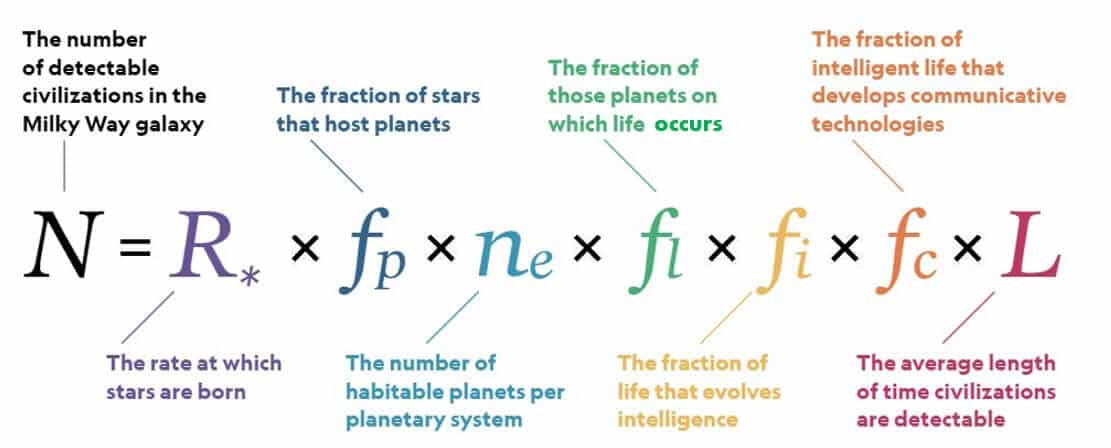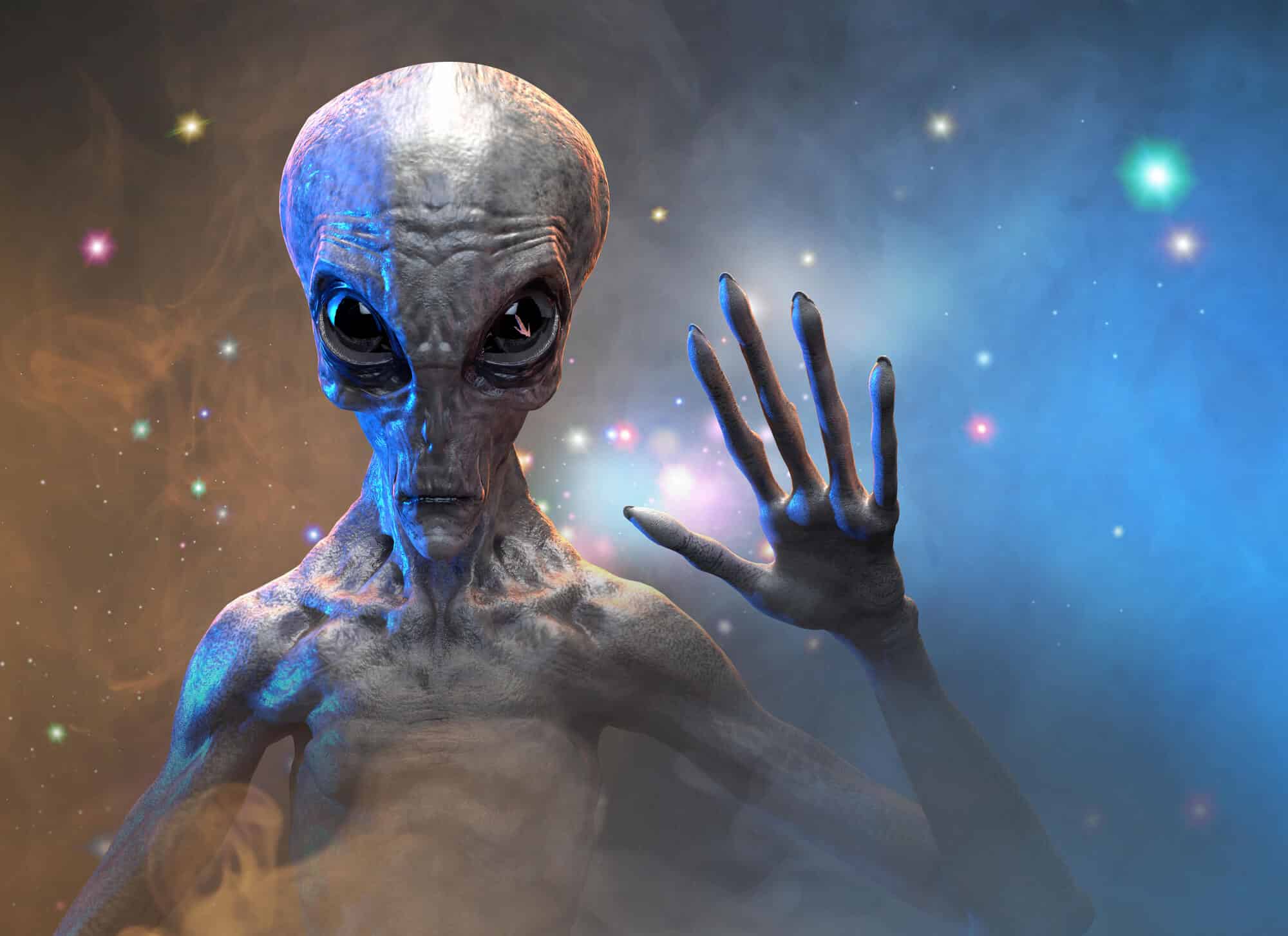The Drake equation is not a law of nature, but an educated estimate of the number of intelligent civilizations we can discover, but it is enough to stimulate the imagination.
By David Rothery Professor of Planetary Geosciences, UK Open University

How many intelligent civilizations should there be in our galaxy right now? In 1961, the American astrophysicist Frank Drake, who died on September 2 at the age of 92, invented An equation to estimate this. The Drake equation, which originated at a point in his career when he was "too naïve to be nervous" (as he later put it), became famous and bears his name.
This places Drake in the company of famous physicists with equations to their name including James Clerk Maxwell, Erwin Schrödinger and many others. Unlike these, the Drake equation does not boil down to a law of nature. Instead it combines several unknown probabilities and turns them into an educated guess.
No matter what reasonable values you enter into the equation (see image below) it is hard to avoid the conclusion that we should not be alone in the galaxy. Drake remained an advocate and supporter of the search for extraterrestrial life throughout his life, but did his equation really teach us anything?
The Drake equation may seem complicated, but its principles are quite simple. It states that in an ancient galaxy like ours, the number of civilizations recognizable by virtue of the fact that they broadcast their presence must be equal to the rate at which they develop, times their average lifespan.
Placing a value on the rate at which cultures develop might seem like a guess, but Drake realized that it could be broken down into more manageable components.
He noted that the total rate is equal to the rate at which suitable stars are formed, times the fraction of those stars that have planets. This is then multiplied by the number of planets capable of bearing life per system, times the proportion of those planets where life has begun, times the proportion of those where life becomes intelligent, times the proportion of those broadcasting their presence.

Complicated values
When Drake first formulated his equation, the only term that was known with any certainty was the rate of star formation in the Milky Way - about 30 per year.
As for the next one to disappear, in the 60s we had no evidence that other stars had planets, and one in ten might seem like an optimistic guess. However, observational discoveries of exoplanets (planets orbiting other stars) beginning in the 20s and prospered in the present century making us certain that most stars have planets.
Common sense suggests that most multi-planet systems will have one at the right distance from its star to be able to support life. Earth is that planet in our solar system. In addition, it is possible that Mars was suitable for abundant life in the past and they can still hold on to it (probably of earthly origin).
We also now understand that planets do not need to be hot enough for liquid water to exist on the surface to support life. the process of the formation of life to occur in the internal ocean of an ice-covered body, which receives heat generated by radioactivity or tides rather than sunlight.
In the solar system there are several possible candidate bodies between the moons of Jupiter and Saturn, for example. In fact, when we add moons as potentially home to life, the average number of habitable bodies per planetary system can easily exceed 1.
However, the values of the terms on the right side of the equation remain open and more challenging. Some would argue that, given a few million years to play with, life would start in any suitable place.
This means that the fraction of suitable bodies where life actually begins is more or less equal to one. Others say that we still have no proof that life originated anywhere other than Earth, and that the origin of life could actually be an extremely rare event.
Will life, once begun, eventually open reason? They probably have to go through the microbial stage and become multicellular first.
There is evidence of this Multicellular life began more than once on Earth, so becoming multicellular may not be a barrier. Others, however, point out that on Earth The "right kind" of multicellular life, which continued to evolve, appeared only once and could be rare on the galactic scale.
Intelligence may give a species a competitive advantage over other species, meaning its evolution may be quite reasonable. But we don't know for sure.
And will intelligent life develop technology to the stage where they broadcast (accidentally or intentionally) their existence throughout space? Maybe for surface dwellers like us, but it might be rare for the inhabitants of the inner oceans of icy, atmosphereless worlds.

How long do cultures survive?
What about the average lifespan of a recognizable civilization, L? Our television broadcasts began to make the Earth detectable from afar in the 50s, and gave minimal value to L of about 70 years in our case.
However, in general, L may be limited by the collapse of civilization (what are our chances of lasting another 100 years?) or by the near-total decline of radio broadcasting in favor of the Internet, or by Intentional choice to "be silent" for fear of hostile galactic inhabitants.
Play with the numbers yourself - it's fun! You will find that if L is more than 1,000 years old, N (The number of civilizations is
identifiable) may be greater than a hundred. in an interview Recorded in 2010, Drake said his best guess for N was about 10,000.
We learn more about exoplanets every year, and are entering an era where we are able to measure the their atmospheric composition To reveal evidence that life is becoming more and more possible. In the next decade or two, we can hope for a much more grounded estimate of the fraction of Earth-like planets where life begins.
It won't tell us about life in the interior oceans, but we can hope for insights into it from exploration missions to the icy moons of Jupiter, Saturn and Uranus- Oron And we could, of course, detect actual signals from extraterrestrial intelligence, mainly by The SETI project.
Either way, Frank Drake's equation, which has inspired so many lines of research, will continue to give us a thought-provoking sense of perspective. For that we should be grateful.
For an article in The Conversation
More of the topic in Hayadan:

8 תגובות
Why are you copying one for another an article in English Frank Drake has passed away but his equation for alien intelligence is mor important than ever
If there's anything really depressing... it's reading the readers' comments on a popular *science* website.
(No need to remind me, I myself am included in that depressing collection)
The obvious problem with the equation is that it assumes independence in the probabilities for the various events.
The equation should have been a conditional probability equation:
That is, the probability of the creation of the universe suppose it is known to exist then with a probability of one.
Now, given that the universe exists what are the chances of life-supporting planets forming. Now, given the universe and a life-supporting planet, what are the chances that life will develop in it, now, given a universe, a life-supporting planet, that has life in it, what are the chances that it will become intelligent
Now, given the universe, a planet that supports life, that has evolved life on it, that has become intelligent, what are the chances that it is intelligent enough that we can locate it.
The product of these conditional probabilities tends very quickly to 0 (because of the definition of the conditional probability) what's more, we don't know how to calculate these probabilities because we don't know the size of the groups of events for everyone. Therefore, the Bayes formula greatly increases the probability because it has many independent parameters that are actually supposed to be dependent, and therefore the product of the probabilities there leads to a value that is very close to 1
The Drake test is based on parameters in most of them
are a reasonable hypothesis. In the bingalactic reality and the evolution that we know, they establish anchor points that to a large extent create a reality that is within the scope of the world image that indeed
Familiar to us. But not all the parameters that Drake tries, stand the test of reality. Examples:
There may be life based on ammonia and not oxygen. Maybe sulfur based, as it turned out
About organisms in the depths of the ocean, when the oxygen required for life is known,
Almost non-existent and in contrast there are volcanoes
Active submarines. All basing on active volcanic sources, as a source of nutrients for life, is largely unknown. Extraterrestrial influences
On the development of humanity, may be a part
From a controversial reality. The negative effects of Spain's involvement in the lives of the Indians are well known
After the discovery of America. On the other hand, a positive effect of "gods from outer space" is known
The Aztecs, Maya and Incas in South America
and the Dogon tribe in Africa. Also in the Middle East
It is claimed ("Aliens from the Past" on the Nistoria channel) that in ancient Egypt, mathematical, astronomical and engineering knowledge was provided for the construction of the pyramids (when it comes to information that was ahead of its time). Also shutting down nuclear facilities in the US and missiles in a way
temporary, proves outsider intervention in what is happening here.
Discoveries published about pyramids on Mars photographed by satellites that scanned it
(in the "Sidonia" area) and the discovery of ancient waterways and rivers there, strengthen the claim that extraterrestrial life is much more common than expected. Also observations
Telescopes in space prove that solar systems with life-supporting planets are common
And much more common than expected. Therefore, these examples are enough to get the impression that the components in the Drake formula are largely different from what they thought
first . Therefore, all these differences in the basic assumptions can greatly change all the probabilities in the equation in question.
Can intelligence be possible without life?
Fuss in clothing!😜There are no aliens outside of our planet they are all here underground (the real ancient sages) not books by explosion believers an obviously unproven theory. Like any theory that smashes in the face of "scientists" after a few years, every day a new theory is invented, come on, you haven't understood the truth yet, a person lives here and goes... where is he going? There are already proven non-descriptive answers here
In order for us to notice intelligent life other than us, scientists need to learn some humility first. Only then will we realize that we are surrounded by wisdom and that we are really not at the top of the ladder.
The question of the possibility of the reality of life can be asked in a different way than in the Drake formula, I will show several other possibilities:-
For example, is the possibility of life somewhere in the cosmos the grand prize in the lottery or an ordinary prize that anyone can win?
Let us examine the difference between these two awards.
Beyond the amounts involved there is another difference between the two prizes and that is the frequency of winning. If it's the big lottery prize, chances are if we win it it will usually be no more than once, but if it's a small lottery prize, chances are we'll win it multiple times.
Therefore, in order to check what the chances are that life will be discovered in other areas of the universe, all that needs to be done is to check whether life of two or at least three different types, whose development is different and separate from each other, has developed on our planet. If this is the case, the development of life is a normal and common reward in the universe.
A different kind of life may be found in the following cases:-
Plants, fungi, germs, viruses, spores, creatures based on mold or other, and more.
The reality of different types of life on Earth will increase by several orders of magnitude the chance of finding civilizations in our galaxy on the "tiny" amount calculated from the Drake formula.
In addition, we can say that if we discover life on another planet in the solar system. Even life like that on Earth, we can say with some certainty that life is common in the universe.
And in addition, in Avi Leib's book "From the First Star to the Last Days, Thoughts to the Sky", in chapter 55, page 15,000,000, Avi Leib talks about an article he published that claims that life appeared about 300 years after the big bang, when the background temperature of the universe was about XNUMX Kelvin , that is, a temperature favorable for the formation of life,
Conclusion - Apparently, life has been widespread throughout the universe since time immemorial!
Sabdarmish Yehuda